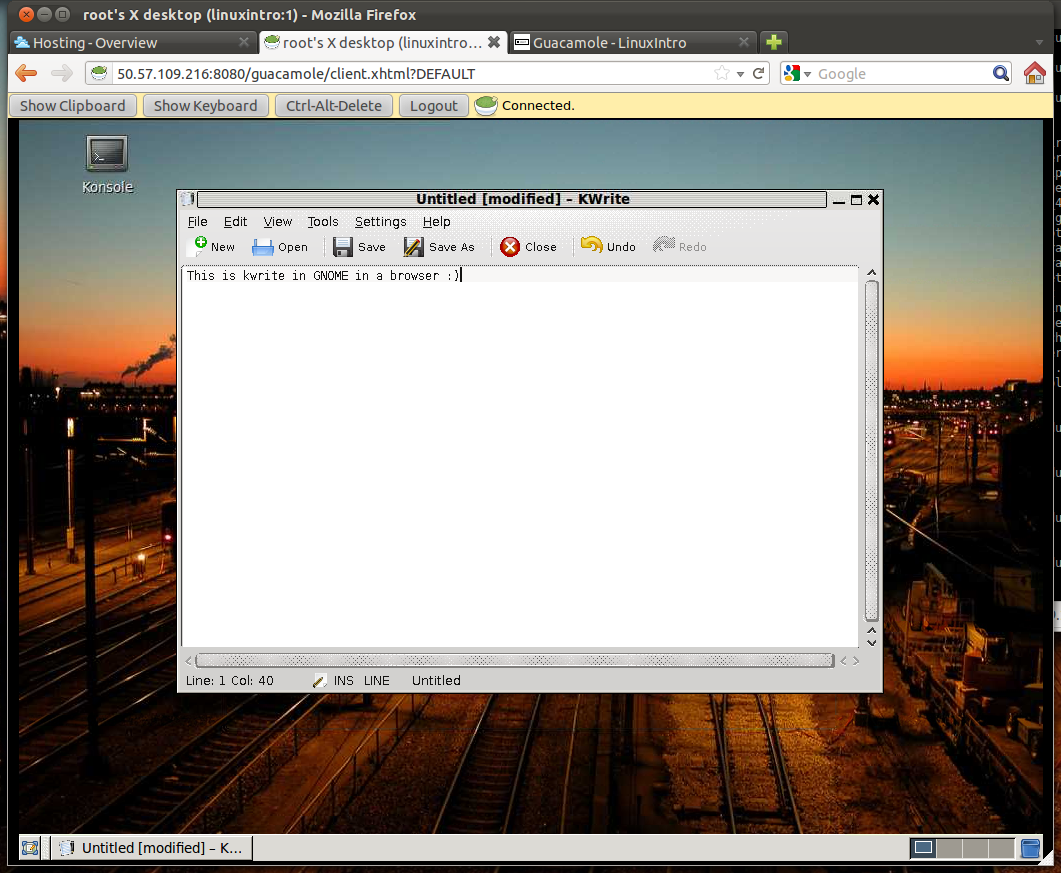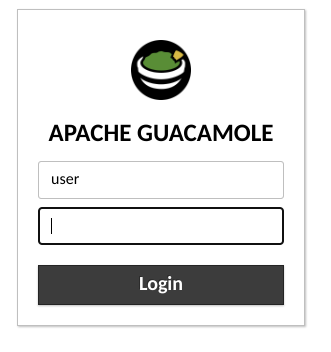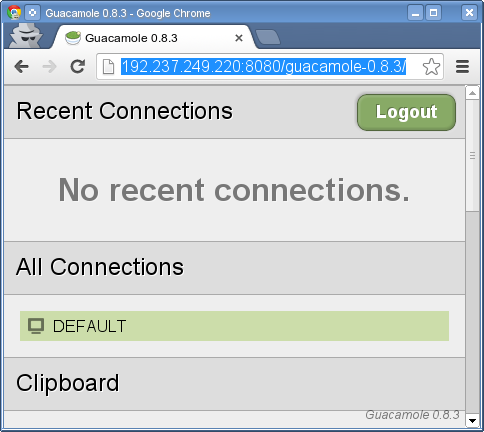Difference between revisions of "Guacamole"
| (15 intermediate revisions by the same user not shown) | |||
| Line 7: | Line 7: | ||
Sometimes in your Linux life, you need to control your servers in the internet with a graphical user interface. This is tedious when you are behind a corporate firewall blocking ssh requests to the public internet. Typical corporate firewalls only allow proxified client access to port 80, 8080 and 443 in the public internet. One way to go is to use a browser to display a Linux desktop. The solution is [http://guacamole.sourceforge.net/ guacamole]. | Sometimes in your Linux life, you need to control your servers in the internet with a graphical user interface. This is tedious when you are behind a corporate firewall blocking ssh requests to the public internet. Typical corporate firewalls only allow proxified client access to port 80, 8080 and 443 in the public internet. One way to go is to use a browser to display a Linux desktop. The solution is [http://guacamole.sourceforge.net/ guacamole]. | ||
| + | |||
| + | <youtube width="200" height="320">1oT7KWK5Lgs</youtube> | ||
= Quickstart = | = Quickstart = | ||
This will show you | This will show you | ||
| − | * how to install guacamole 1. | + | * how to install guacamole 1.5.2 on Ubuntu (tested with 20.04) |
* how to make this configuration survive a reboot | * how to make this configuration survive a reboot | ||
* how to secure transmission with SSL | * how to secure transmission with SSL | ||
* how to make the website accessible from behind a firewall (port 80 or 443) | * how to make the website accessible from behind a firewall (port 80 or 443) | ||
| − | Here's what you do | + | Here's what you do: |
| + | * become root user | ||
| + | sudo su - | ||
* install software that we will need later: | * install software that we will need later: | ||
apt-get update | apt-get update | ||
| − | apt-get install tomcat9 tightvncserver | + | apt-get install tomcat9 tightvncserver ubuntu-gnome-desktop xfonts-75dpi xfonts-100dpi gnome-panel |
== configure VNC server == | == configure VNC server == | ||
| Line 35: | Line 39: | ||
gnome-session --builtin --session=gnome-flashback-metacity --disable-acceleration-check --debug & | gnome-session --builtin --session=gnome-flashback-metacity --disable-acceleration-check --debug & | ||
EOF | EOF | ||
| + | chmod +x .vnc/xstartup | ||
== deploy guacamole client == | == deploy guacamole client == | ||
| − | * download the guacamole webapp | + | * download the guacamole webapp, today, 1.5.2 is the latest: |
| − | * deploy it | + | wget https://archive.apache.org/dist/guacamole/1.5.2/binary/guacamole-1.5.2.war |
| − | + | * deploy it | |
| − | * | + | mv guacamole-1.5.2.war /var/lib/tomcat9/webapps/guacamole.war |
| + | * test it by surfing to http://yourserver:8080/guacamole (don't forget to replace yourserver by your server or your server's IP address ;) | ||
* although login is not yet possible your browser will show a login screen like that: | * although login is not yet possible your browser will show a login screen like that: | ||
| − | <pic src= | + | <pic src=https://linuxintro.org/images/4/44/Screenshot_2023-09-21_2.56.57_PM.png width=25% align=text /> |
== install guacamole server == | == install guacamole server == | ||
* install some [[dependencies]] that the server will need to build with vnc support: | * install some [[dependencies]] that the server will need to build with vnc support: | ||
| − | apt-get install libvncserver-dev libpng-dev libcairo-dev libossp-uuid-dev | + | apt-get install gcc make libvncserver-dev libpng-dev libcairo-dev libossp-uuid-dev |
| − | * download guacamole-server, in this case version 1. | + | * download guacamole-server, in this case version 1.5.2: |
| − | wget https://archive.apache.org/dist/guacamole/1. | + | wget https://archive.apache.org/dist/guacamole/1.5.2/source/guacamole-server-1.5.2.tar.gz |
| − | * unpack it | + | * unpack it: |
| − | tar xvzf guacamole-server-1. | + | tar xvzf guacamole-server-1.5.2.tar.gz |
* build the server: | * build the server: | ||
| − | cd guacamole-server-1. | + | cd guacamole-server-1.5.2 |
./configure && make -j8 && make install | ./configure && make -j8 && make install | ||
* the following step is ugly; installation and binary do not completely fit so we must do that: | * the following step is ugly; installation and binary do not completely fit so we must do that: | ||
| Line 60: | Line 66: | ||
* now we start the guacamole daemon: | * now we start the guacamole daemon: | ||
# guacd | # guacd | ||
| − | guacd[ | + | guacd[54873]: INFO: Guacamole proxy daemon (guacd) version 1.5.2 started |
== configure guacamole == | == configure guacamole == | ||
Latest revision as of 16:51, 30 December 2023
 |
A Linux desktop in a browser |
Overview
Guacamole is a program to control a Linux desktop over the network in a browser.
Sometimes in your Linux life, you need to control your servers in the internet with a graphical user interface. This is tedious when you are behind a corporate firewall blocking ssh requests to the public internet. Typical corporate firewalls only allow proxified client access to port 80, 8080 and 443 in the public internet. One way to go is to use a browser to display a Linux desktop. The solution is guacamole.
Quickstart
This will show you
- how to install guacamole 1.5.2 on Ubuntu (tested with 20.04)
- how to make this configuration survive a reboot
- how to secure transmission with SSL
- how to make the website accessible from behind a firewall (port 80 or 443)
Here's what you do:
- become root user
sudo su -
- install software that we will need later:
apt-get update apt-get install tomcat9 tightvncserver ubuntu-gnome-desktop xfonts-75dpi xfonts-100dpi gnome-panel
configure VNC server
Guacamole does the communication between a VNC server and the web browser. So whatever you see in VNC will be in the browser. In this example let's use GNOME as desktop environment:
- write the startup for your VNC sessions:
cd mkdir .vnc cat >> .vnc/xstartup <<EOF #!/bin/sh export XKL_XMODMAP_DISABLE=1 export XDG_CURRENT_DESKTOP="GNOME-Flashback:GNOME" export XDG_MENU_PREFIX="gnome-flashback-" gnome-session --builtin --session=gnome-flashback-metacity --disable-acceleration-check --debug & EOF chmod +x .vnc/xstartup
deploy guacamole client
- download the guacamole webapp, today, 1.5.2 is the latest:
wget https://archive.apache.org/dist/guacamole/1.5.2/binary/guacamole-1.5.2.war
- deploy it
mv guacamole-1.5.2.war /var/lib/tomcat9/webapps/guacamole.war
- test it by surfing to http://yourserver:8080/guacamole (don't forget to replace yourserver by your server or your server's IP address ;)
- although login is not yet possible your browser will show a login screen like that:
install guacamole server
- install some dependencies that the server will need to build with vnc support:
apt-get install gcc make libvncserver-dev libpng-dev libcairo-dev libossp-uuid-dev
- download guacamole-server, in this case version 1.5.2:
wget https://archive.apache.org/dist/guacamole/1.5.2/source/guacamole-server-1.5.2.tar.gz
- unpack it:
tar xvzf guacamole-server-1.5.2.tar.gz
- build the server:
cd guacamole-server-1.5.2 ./configure && make -j8 && make install
- the following step is ugly; installation and binary do not completely fit so we must do that:
ln -s /usr/local/lib/libguac.so* /lib ln -s /usr/local/lib/libguac-client-vnc.so* /lib/
- now we start the guacamole daemon:
# guacd guacd[54873]: INFO: Guacamole proxy daemon (guacd) version 1.5.2 started
configure guacamole
- create a folder for guacamole's configuration:
mkdir /etc/guacamole
- create a file /etc/guacamole/guacamole.properties with the content
# Hostname and port of guacamole proxy guacd-hostname: localhost guacd-port: 4822 # Location to read extra .jar's from lib-directory: /var/lib/tomcat9/webapps/guacamole-1.3.0/WEB-INF/classes # Authentication provider class auth-provider: net.sourceforge.guacamole.net.basic.BasicFileAuthenticationProvider # Properties used by BasicFileAuthenticationProvider basic-user-mapping: /etc/guacamole/user-mapping.xml
- create a file /etc/guacamole/user-mapping.xml with the content
<user-mapping>
<authorize username="user" password="password">
<protocol>vnc</protocol>
<param name="hostname">localhost</param>
<param name="port">5901</param>
<param name="password">password</param>
</authorize>
</user-mapping>
configure tomcat
- find out your tomcat's user directory:
# cat /etc/passwd|grep tomcat tomcat6:x:113:116::/usr/share/tomcat9:/bin/false
- in this case it is /usr/share/tomcat9
- create a folder .guacamole in your tomcat's user directory:
mkdir /usr/share/tomcat9/.guacamole
- link guacamole.properties into your tomcat's user directories' guacamole folder
ln -s /etc/guacamole/guacamole.properties /usr/share/tomcat9/.guacamole
finishing
- start a vnc server, as password set password (the vnc password given in user-mappings.xml)
vncserver
- if it requires a password, use password. Don't set a view-only password.
- point your browser to http://localhost:8080/guacamole
- log in as user, password password (the user given in user-mappings.xml)
- you should see a screen like this:
Now when you click on "Default" you will see your VNC desktop in your browser.
secure transmission
Set up apache for https so your passwords are not transmitted unencrypted over the internet
make it work from behind a firewall
Most companies will have an internet proxy that does not allow users to access port 8080 on a server outside the company network. So you need a reverse proxy that tells apache if someone calls http://yourserver.yourdomain/guacamole this is forwarded to http://yourserver.yourdomain:8080 internally. To do this,
- edit /etc/sysconfig/apache2 and add the following words to APACHE_MODULES: proxy proxy_http. In the end your line may read like this:
APACHE_MODULES="actions alias auth_basic proxy proxy_http authn_file authz_host authz_groupfile authz_default authz_user autoindex cgi dir env expires include log_config mime negotiation setenvif ssl userdir php5"
- edit /etc/apache2/default-server.conf, add a block
<IfModule mod_proxy.c>
<Location /guacamole>
ProxyPass http://127.0.0.1:8080
</Location>
</IfModule>
Persist it
You want your configuration to survive a reboot so add the following lines to /etc/crontab:
@reboot root /usr/local/sbin/guacd & @reboot thorsten USER=thorsten /usr/bin/vncserver >>/tmp/vnc-startup-error 2>&1
Replace thorsten with the OS user to start vncserver.
Beautify it
You may want to run bash as a shell, in this case edit /etc/passwd and enter /bin/bash instead of /bin/sh
TroubleShooting
invalid login
- now the problem is that tomcat does not know where to find the Authentication class:
/var/lib/tomcat6/webapps/guacamole/WEB-INF/classes/net/sourceforge/guacamole/net/basic/BasicFileAuthenticationProvider.class
is not in /etc/guacamole/guacamole.properties
- so add it
- cat /etc/passwd gives me a line
tomcat6:x:113:116::/usr/share/tomcat6:/bin/false ll /usr/share/tomcat6/.guacamole/ total 8 drwxr-xr-x 2 root root 4096 Nov 26 07:58 ./ drwxr-xr-x 6 root root 4096 Nov 26 07:57 ../ lrwxrwxrwx 1 root root 35 Nov 26 07:58 guacamole.properties -> /etc/guacamole/guacamole.properties
- works now. So the thing is:
- take care that it is called guacamole and not guacamole-0.8.3 (sure?)
- make sure the classpath in /etc/guacamole/guacamole.properties is correct, e.g.
# Location to read extra .jar's from lib-directory: /var/lib/tomcat6/webapps/guacamole/WEB-INF/classes
Server error
- now I got a server error so I straced guacd:
strace -p 15332
and saw
[pid 20344] open("/usr/lib/x86_64-linux-gnu/libguac-client-vnc.so", O_RDONLY) = -1 ENOENT (No such file or directory)
so the problem is that libguac-client-vnc.so is missing.
- downloaded java version 1.7.45 and compiled guacamole-client using mvn. But there was no *.so* file in it
- so installed libvncserver-dev and rebuild and reinstalled guacamole-server
- and there it is, libguac-client-vnc.so
- now the error message changed from "server error" to "unauthorized"
Failed to load
When logging in I got an error message
Failed to execute 'send' on 'XMLHttpRequest': Failed to load 'http://162.209.103.145:8080/guacamole-0.8.3/login'.
Solution was to:
/etc/init.d/tomcat6 restart
Error initializing VNC client
After logging in I got the error message
Error initializing VNC client
Solution was to start
vncserver
Could not connect
If you surf to the page and get an error message like
Unable to connect
It probably means that tomcat is not running. It must be possible to connect to port 8080, a java process for tomcat must be running.
/etc/init.d/tomcat6 status
must deliver something like
* Tomcat servlet engine is running with pid 17546
See also
- connect to a Linux computer
- guacamole 0.8 on SUSE
- guacamole 0.3.0 on Ubuntu 10.04
- cool things
- schedule tAsks
- http://guac-dev.org/Debian%20Install%20Instructions
- ulteo
- http://www.filegott.se/prd/index.php/how-tos/19-how-to-setup-guacamole-in-linux-ubuntu
- http://guac-dev.org/doc/gug/installing-guacamole.html#idp99200

